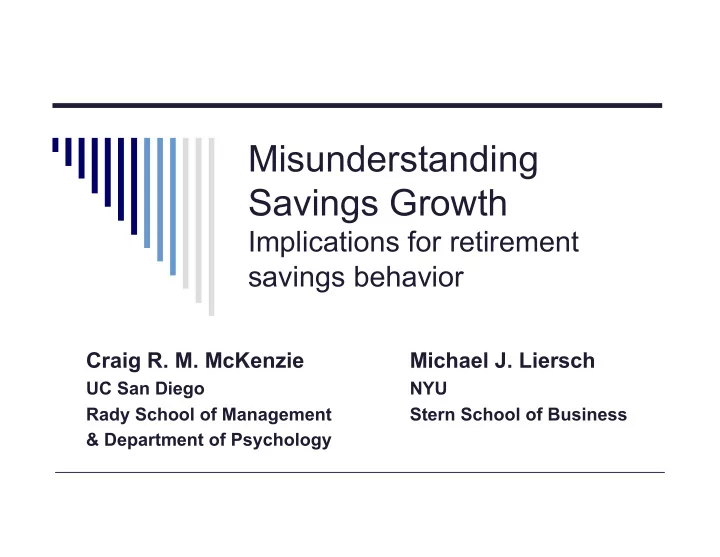

Misunderstanding Savings Growth Implications for retirement savings behavior Craig R. M. McKenzie Michael J. Liersch UC San Diego NYU Rady School of Management Stern School of Business & Department of Psychology
Background Rapid change in US retirement plans from defined benefit plans (i.e., pensions) to defined contribution plans (e.g., 401 (k) plans) Responsibility of saving for retirement shifted from employers to employees Reason to believe that employees not saving enough
Our Focus Traditional accounts of insufficient saving (e.g., excessive intertemporal discounting, weakness of will) implicitly assume that people understand the basics of savings We show that undergraduates fail to appreciate the exponential growth of savings and the cost of waiting to save Other research has shown that exponential growth is massively underestimated We test interventions to help increase savings
How much money would you have if you deposited … $400/mo for 20 years at 10%? $302,412 $400/mo for 40 years at 10%? $2,336,889
Experiment 1: Can participants generate the correct growth pattern? Assume that you deposit $400 [$200] every month into a retirement savings account that earns a 10% [5%] yearly rate of interest. (You never withdraw any money.) How much money do you think you will have in your account (including interest earned): After 10 years? $_____ After 20 years? $_____ After 30 years? $_____ After 40 years? $_____ 2 conditions (N = 99; undergraduates): Aid (calculator provided) We requested participants’ calculated answer No Aid (no calculator provided) We requested participants’ best guess
Experiment 2: Can participants recognize correct pattern of growth? (N = 100) Imagine that you deposit $100 every month into an account that earns 10% interest, compounded annually. You never withdraw any money. Which of the charts below best shows how the money in your account will increase over 40 years? Please place a mark next to one chart. Chart A years: 0 years 10 years 20 years 30 years 40 years 78% $: $0 $21,037 $75,603 $217,132 $584,222 Chart B years: 0 years 10 years 20 years 30 years 40 years 22% $: $0 $146,056 $292,111 $438,167 $584,22
Experiment 2: Can participants recognize correct pattern of growth? (N = 100) Imagine that you deposit $100 every month into an account that earns 10% interest, compounded annually. You never withdraw any money. Which of the charts below best shows how the money in your account will increase over 40 years? Please place a mark next to one chart. Chart A years: 0 years 10 years 20 years 30 years 40 years 50% $: $0 $21,037 $75,603 $217,132 $584,222 Chart B years: 0 years 10 years 20 years 30 years 40 years 50% $: $0 $13,200 $26,400 $39,600 $52,800
Experiment 3: Do people underweight cost of waiting to save? (N = 100) Imagine that both ALAN and BILL just started working and are going to retire in 40 years ALAN deposits $100 every month into his retirement account BILL waits 20 years to start saving, but then deposits $300 every month into his retirement account Both accounts earn 5% [10%] interest every year, compounded annually. Neither of them withdraws any money. Annual Actual: Participants: Actual: Participants: Return Who has Who has more How much does How much does Bill more money? Bill need to save need to save to money? to catch up? catch up? (median) 5% Alan 36% correctly $365/mo $200/mo ($152k vs. chose Alan (45% of responses) $125k) 10% Alan 30% correctly $773/mo $200/mo ($584k vs. chose Alan (52% of responses) $227k)
Experiment 4: Does highlighting effect of compound interest increase saving? (N=276) Procedure: 1. Asked about willingness to save 2. One of 3 interventions introduced 5. Re-asked willingness to save, plus Alan and Bill Qs Sample questions: If you deposited $100 each month , about how much Sample questions: If you deposited $100 [$200] each month , about how Time Deposit Control money would you have after 20 [40] years ? much money would you have after 20 years ? Intervention Intervention Intervention $ __________ $ __________
S’s turned in first part of survey, answered additional questions
Experiment 5: Intervention in the field Employees at a Fortune 100 Company recruited via email for an online study and randomly assigned Study Participants Using the S’s actual 401(k) data, N 250 they saw either their current account balance or their Mean Age (years) 37 estimated future account balance Female (%) 47 at retirement Mean Tenure (years) 7 E.g., 30-yr-old S depositing $4k/yr Mean Deferral Rate (%) 3 with $40k would see either $40k Mean Total Balance ($) 28,627 current balance or future estimated balance of over $500k Estimated Annual Salary ($) 37,048
The percentage of employees either less, equally, or more interested in “saving more” AFTER seeing the control/intervention Less Equally More Interested Interested Interested Dollar amount viewed by participants Total account balance (Control) 8% 65% 27% Estimated account balance at retirement 9% 50% 41% (Intervention) Employees were significantly more interested in “saving more” after seeing their estimated account balance at retirement
What did he say? Participants believe savings grow linearly, leading to massive underestimation, especially for long periods of time and high interest rates S’s don’t even reliably recognize correct pattern This leads to underestimating cost of waiting to save Understanding compound interest doesn’t help Interventions highlighting exponential growth of savings increased (a) accuracy of savings growth estimations, (b) motivation to save early, and (c) predictions of future monthly savings rates For both undergraduates and real employees Intervention mentions nothing about compound interest, what it is, or how to calculate it
Recommend
More recommend